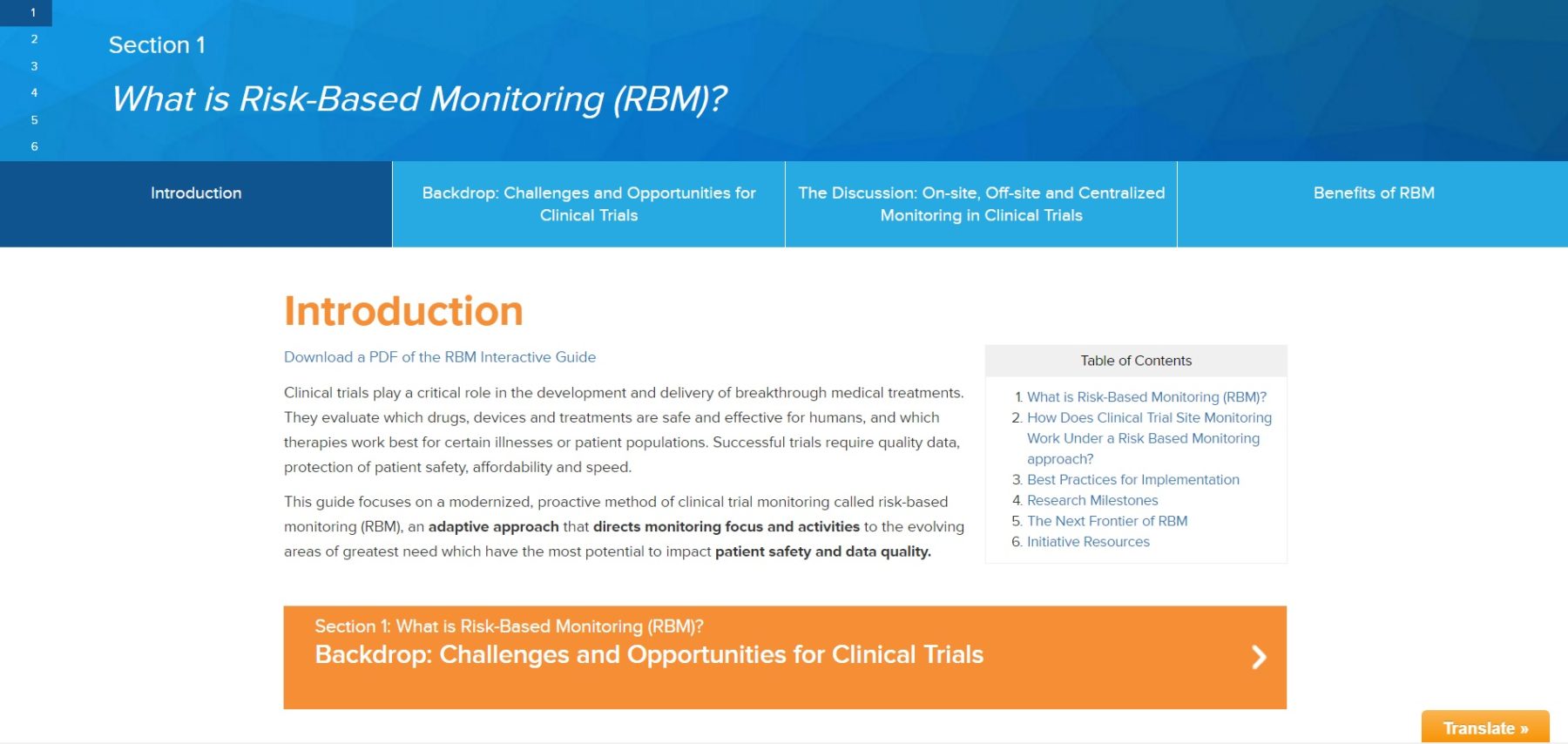TransCelerate BioPharma was established as a non-profit back in 2012 to allow pharmaceutical companies to collaborate on solutions to common pain points in research and development. One of their first initiatives dealt with risk-based monitoring (RBM), a proactive method of clinical trial monitoring in which focus is shifted to the evolving areas of greatest need with the most potential to impact patient safety and data quality. And now, the organization is making all of their findings on the subject available via a handy Risk-Based Monitoring Interactive Guide.
While TransCelerate has published papers on RBM in the past, this guide compiles all of the research, tools, templates, findings, and resources on RBM that they have developed over the past four years in a single location. This central hub for all things RBM makes it easier for companies unfamiliar with the method to quickly adapt it using well-vetted resources that incorporate several years of lessons learned from companies that were early adopters of RBM. But the guide also looks to the future of RBM to help those already familiar with the method to prepare for what is next.
“When you talk about RBM, it really starts with embedding quality by design and a robust assessment of risk upfront,” explains Justin Stark, Head/Director, Risk Based Monitoring and Standards at UCB. “This involves focusing on what is critical in terms of data and process to ensure the safety and rights of patients, while also ensuring the critical data being collected is of exceptional quality.”
Traditionally, companies rely on having a clinical research associate (CRA) on-site to detect issues and ensure everything is running as expected. But by utilizing data surveillance and the most efficient mechanisms possible to adequately monitor and address risks, companies are able to better identify risks and then proactively triage and manage those risks to ensure they don’t become something more systemic. This can also help to reduce cycle times because taking a more targeted and adaptive approach—rather than the traditional one-size-fits-all—allows companies to take the right intervention at the right time in a timely manner.
The guide will continue to be updated with additional resources in the near future, including a site risk assessment framework as well as two additional resources focused around the International Council for Harmonisation of Technical Requirements for Pharmaceuticals for Human Use (ICH) E6 Guideline for Good Clinical Practice.
What’s Next for Risk-based Monitoring
As for those already familiar with RBM, Stark says that he expects it to evolve and mature along with the rest of the clinical development landscape.
“On the horizon within the clinical development paradigm there will continue to be increasing synergies and capabilities to do more with quality and knowledge management,” Stark says. “Additionally, with the increasing availability and adoption of technology, we will see continued digitization across the clinical landscape. So, if you think about concepts like e-consent, wearables, and potential advancements in machine learning capabilities, all of these are very complementary to RBM across the industry. So as those types of efforts mature, that will continue to evolve what RBM looks like.”
What Else is New at TransCelerate
RBM is not the only area within R&D that TransCelerate is working to improve. The organization also recently published a clinical quality management paper that provided a framework they developed for the different quality management subtopics such as issue management, knowledge management and, the general design of a quality management system.
“The airline industry developed a quality management system back in the early ’90s, and you wouldn’t like to board a plane without a quality management system nowadays,” explains Ulo Palm, Senior Vice President, Product Development Operations at Allergan and Chair of the Oversight Committee at TransCelerate. “But the pharmaceutical industry did not have a consistent quality management system for research and development, which articulates the general principles of quality management, until we released that framework in 2016.”
Another clinical initiative TransCelerate is working on is a common protocol template. Up to now, every company has its own way of documenting clinical studies. So while one company might follows structure in which they had informed consent of a patient in chapter three, the other ones may put it into chapter nine. This can cause errors when you consider that physicians conduct multiple studies, and may make mistakes based on what format they expect to see. The same is true for ethics committees and regulators. So, TransCelerate developed a common protocol template that anyone in the industry can use, which has been downloaded more than 2,000 times over the last year.
“The next step is to make the common protocol template machine readable, which opens up big opportunities,” Palm adds. “Because once you have a machine-readable protocol, you can begin to automate, which could cut three to five months in overall product development time.”
While something like that is further down the road, another recent project from TransCelerate that could offer more present results is the Placebo (standard of care) Data Sharing project. This involves building a shared database for participating companies containing thousands of historical patients, which can be used for modeling simulation and possibly, eventually the ability to replace a placebo arm of a clinical trial with historical controls.
“Clinical trial recruitment is always a challenge because patients don’t want to be on placebo,” Palm explains. “They want to be on an active drug. And in cases when it is a life-threatening disease, it even poses a clear ethical issue to place some patients on placebo. But we think it is feasible, under certain circumstances, to run a study mostly with the active drug and then use this database as a reference for historical controls.”
One area that TransCelerate is just starting to look at is patient experience and how to ease the burden for patients participating in clinical trials, as well as making it easier to access and find clinical trials. But, according to Palm, those efforts are still in the very early phases of being examined. It is just one more thing from TransCelerate that companies trying to improve their R&D processes can look forward to.






